Power Plants
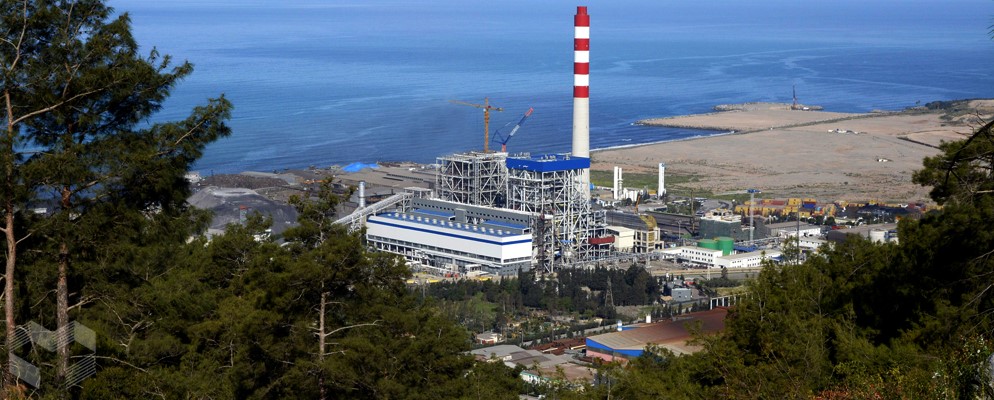
ATLAS ENERJİ ÜRETİM A.Ş. HATAY
As USER ENGINEERING, we have many installations with our Sonic Cleaning products. In our power plants; We apply in the marked sections. Today, our installations are running smoothly and successfully.
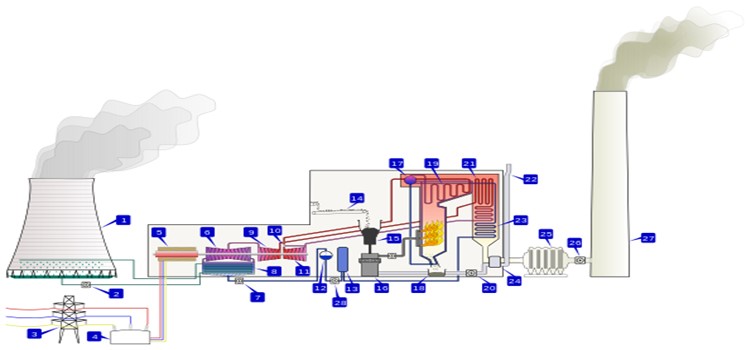
Our successful installation areas are SPH - RHT - ECO - Filters, silos, etc.
The chemical energy obtained as a result of combustion of fuels such as coal, lignite, fuel oil, biomass is converted into electricity in thermal power plants. These plants are quite complex and they are of great importance in supplying electricity to many countries. Thermal power plants are the systems that convert the chemical energy released by the combustion of coal and coal-derived fuels into mechanics and mechanical energy into electrical energy. Different boiler systems are used in these facilities.
The boiler is the section where the heat is obtained by burning the fuel with various ignition systems. The temperature of the boiler varies between 800 - 1300 °C depending on the type of boiler. There are many types of energy power plant boilers. Some of those;
- Pulverized-coal fired boiler
- Biomass boiler
- Waste heat boiler
- Akışkan Yataklı Kazanlar
- Fluidized-bed boiler
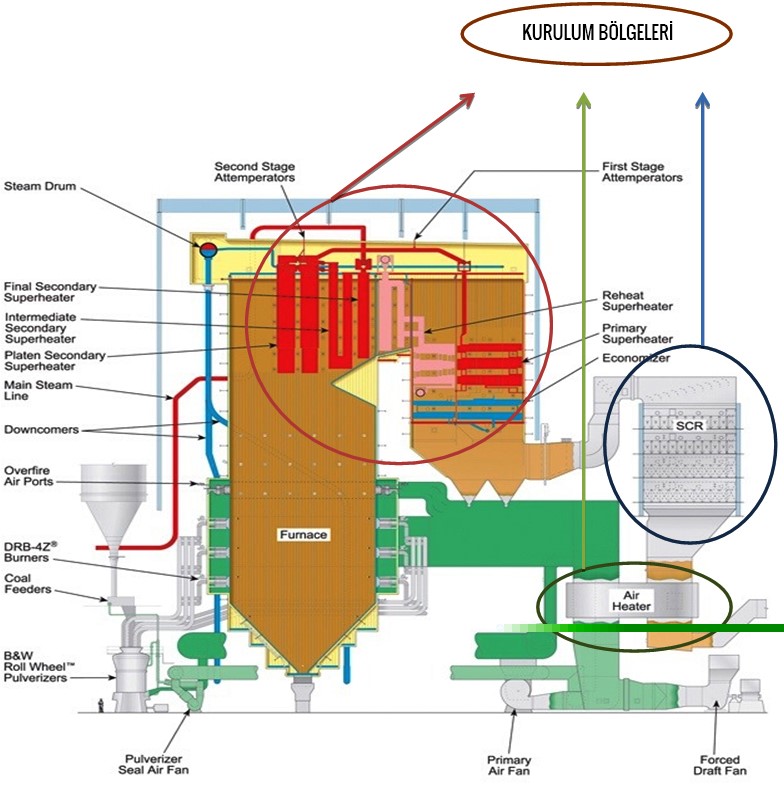
FUEL EFFECTS ON POWER PLANT EFFICIENCY
The main raw material input in coal-fired thermal power plant is coal. The physical and chemical properties of the coal to be burned in the boiler should be in accordance with the boiler design properties. but such, the boiler can be high performance and efficient. This directly affects plant efficiency and performance. In Turkey, the coal burned in the power plants goes out of the design values of the boilers where they are burned due to the ash ratio and the amount of water they contain. The fact that the ash ratio of the coal calculated in the boiler design is less than the real ash ratio causes major problems affecting the production in inside the boiler. In this case, too much will occur ash in the boiler. This increases wear in the pressure pipes of the boiler. Especially in superheater and economizer pipe bursts occur. In addition, due to excessive ash and slag, disposal of these from the boiler will be delayed, there will be a load drop in the unit and will cause the unit to fail.
Pollution increases heat build-up. The difference a normal operating period or a clean operating situation can be estimated even from the surfaces of the boiler tubes due to the increase in stack temperatures.
The boiler efficiency loss flue gas temperature is approximately 1% for each 400 F (4.44 ° C).
In a high temperature environment the accumulation of soot on the heating line prevents the heat transfer of the boiler heat transfer surfaces. The less heat transfer to the water boiler, the more heat remains in the flue gases. Thus, it occurs loss of heat build-up.
As shown in the table, each 1/32 inch thick soot layer reduces boiler efficiency by 2.5%.
| Reduction of boiler efficiency due to contamination. | |||
|---|---|---|---|
| Soot layer thickness | 1/32 inch. | 1/16 inch. | 1/8 inch. |
| boiler efficiency drop rate | 2,50% | 4,50% | 8,50% |
* gived application note - Energy efficiency operation and maintenance strategies for industrial gas boilers, pacific gas and electricity company, May 1997 USA.
User Sonic Soot Blower (User Sonic Soot Blowers)
One of the biggest advantages of sound cleaning; the sound affects everywhere where the flue gas velocity is at least 5 m / s if the pressure level is high enough. This means that you can have this effect even in the middle of thick and finned tube packs. When the sound pressure level is high enough, the boundary layer on each surface will be almost zero. This means that your own flue gas velocity will drag the accumulated ash particles. because of we do cleaning very often, the average thickness of ash accumulation will be less compared to other cleaning methods for this system. Thus, This will increase the heat transfer.
As an additional effect in heat exchangers and especially in the economizer; the peak ash volume to be released into the flue gas stream for 10 seconds every 7-10 minutes is less. Thus, this is relieved the existing filter suction capacity.
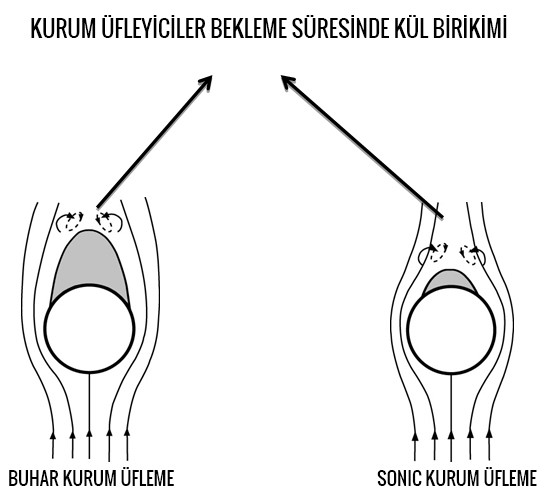
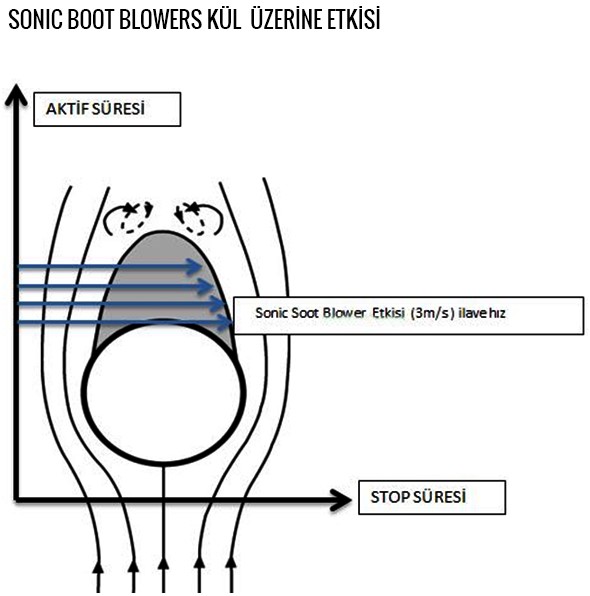
COMPARİSON OF SONİC EFFECT WİTH STEAM SOOT BLOWER.
The basic principle of Sonic soot blower; On the bundles of pipes is to generate a sound wave having an energy level above the force which forces the ash particles carried by the hot flue gas to connect to each other. The particles are separated from the bonds (surface and other particles) they have formed before forming a hard layer. thus, accumulation formation is prevented. unaccumulated ash on the surfaces is discharged to the ESP and bag filter system with gas flow. As shown in the graph; The ash density and flue gas heat increase in a system operating with steam soot blowers are 50% higher than with sonic soot blowers.
In the following ash formation shape graph, a sample model was created for steam soot blower and sonic soot blower. The ash density in the boiler increases the flue gas temperature in time. In a system with a capacity of 1.5 MW, the flue gas outlet temperature is optimally 150 ºC. However, after 48 hours, the exhaust temperature increases by 25 ºC due to the ash density. The result is an energy loss of 1.2%.
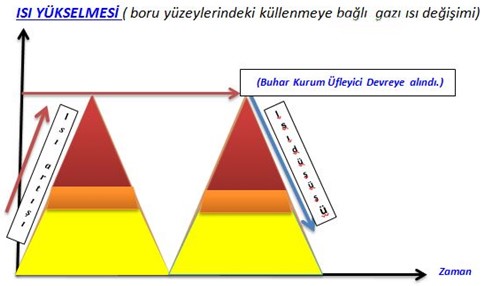
Steam soot blowers are usually commissioning at shift intervals or at the time intervals specified by the company for very specific conditions but the commissioning intervals usually involve long waiting times. The ash accumulated during these periods adheres to the surfaces over time (due to heat) and forms a thick layer. Steam soot blowers cannot achieve the effect they create at the front regions in deeper regions. So, the effect is not same every region. The dry steam generated by the system is needed for this process and causes energy loss.
In sonic soot blowers the situation is completely different. The system only works with 6 bar air and does not consume dry steam when it is activated. The sound effect is examine in detail in our software programs. Installation is made considering that the sound pressure will 135 Db at the farthest point. In this way , the sound effect is destructive at every stage. The insonation cycle is automatically calculated taking into account the ash densities in the process. Since the system will be active more frequently, accumulation and layer formation on the heat transfer surfaces will prevented. Wear is caused by Steam Soot Blowers on the heat conduction surfaces and consequently material changes cause the power plants to make expensive stops. When sonic soot blower is used, there is no damage to the heat transmission lines. So, no stops occur depended to the sonic system .
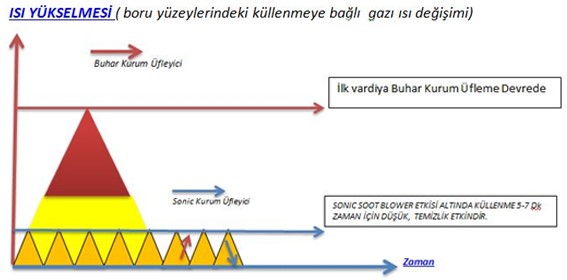
One of the strongest arguments for using a sonic soot blower is that it is applied continuously to prevent buildup of heat transfer surfaces. Sonic cleaning has proven to be a cost-effective solution with numerous power plant applications. The Sonic system has been successfully installed in superheaters, electrostatic precipitators (ESP) and filtration units of oil, coal and biofuels. The Sonic system is successfully installed for the electro-static precipitators (ESP), filtering units, superheater of power plants working with coal, petroleum and biofuel until today. The Sonic soot blowers have a lot of work cycle as shown in the graph above. When we compare the steam blower which is activated twice a day for 1 period, it gives us 90% more working cycles in a 12 hour period. The sonic cleaning cost is very low when with the other systems compare. (Sonic soot blower costs are less than half compared to cleaning with steam soot blower system in the same volume.)
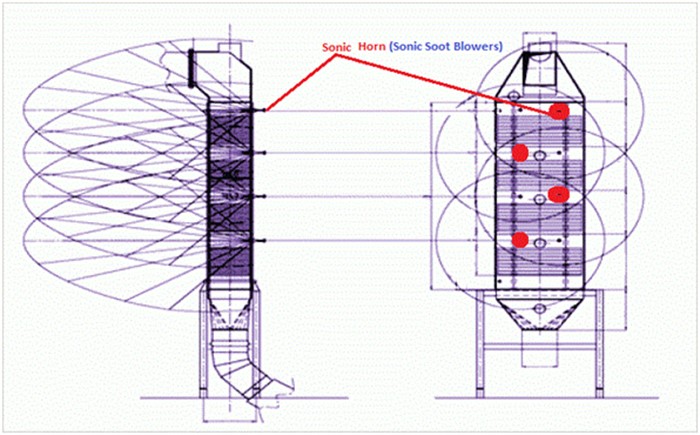
Areas of influence of Sonic horns placed on the Super Heater Air Heater line in the Energy Power Plant.
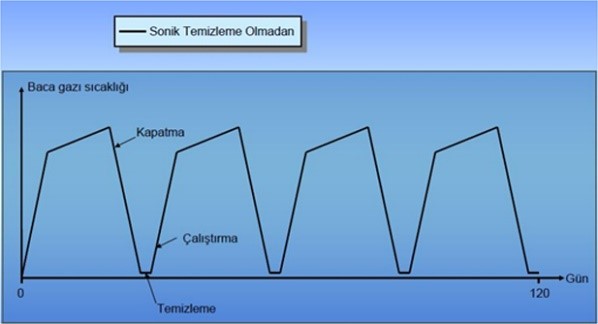
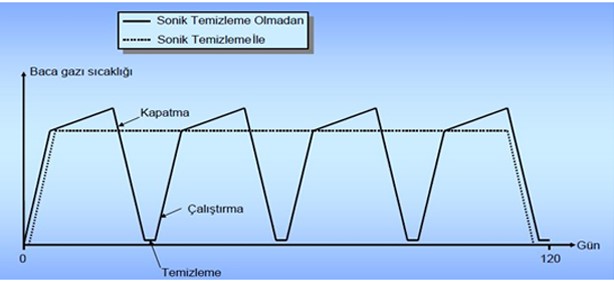
The results of this effect for energy power plants are;
- Reduces fuel consumption by about 2% and heat transfer is ensured by surfaces that are constantly clean.
- The following situations occur as a result of decrease in the stop periods.
- The days used to discharge the battery are reduced.
- Days in waiting state are reduced.
- The need for manual cleaning is reduced.
- Days spent running the boiler are reduced.
- Erosions in the structure of the boiler is reduced.
- More efficient heat and power generation is provided.
- Pipe's life increases by 20%. Thus, mechanical and abrasive effects on surfaces are reduced.
- Low energy consumption
- Low maintenance costs
- Furthermore, high pressure steam is not drawn from the steam turbine for steam soot blowers. Thus, a 5 - 10% increase in the energy production of the power plant occurs.
